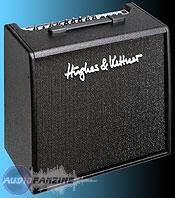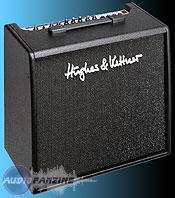View other reviews for this product:
Published on 05/15/09 at 03:34
Amp transistor (MOSFET I think), a power of 50 watts RMS. Large two channels plus reverb. An EQ common to both channels and a spring reverb (spring reverb).
It features an auxiliary input to connect a CD player for example the play back, or any other source format audio RCA. on the other hand is not suitable for connecting a microphone singing.
Last detail for the connection: it has a optional footswitch to switch channels and an effects loop.
The HP is a Celestion Rockdriver a G12t60 to be exact, which by its size of 12 inches can have a good record, with these serious and good dispersion.
The production is strong, we feel it's a solid amp, "build to last" as they say ...
UTILIZATION
The settings are simple: a gain on the clean, gain and master for the overdrive, a master general.
The EQ is very effective on all three bands (low, mid and treble), and allows much change the color of sound.
The only downside is that it is common to both channels, which limits somewhat the possibilities of adjustment, but the use can easily be found a compromise that goes to both channels.
SOUNDS
Regarding the sound:
- The clean channel is really good for an amp of this range, with an effective equalizer allows for a range of interesting sounds.
Beyond the clean half of the gain, you get a crunch sound good, well-typed Ac / dc in the 70's style, bluesy at will, or typed big rock.
For the saturated gain is large, the only downside is that it starts a little too loud for my taste, a setting for less gain would be more suited to my style, but it offers a good range, rather typed big blues rock, with a possibility of its metal digging mediums, but this is not an amp built for this. Best for metalheads will add a dedicated pedal. Personally, I had the opportunity to play top with a metal box, the result, by adjusting the pedal is much more credible than ...
I've had several years when I played it with several guitars, whether Lag, Jackson, Schecter and Duesenberg. It enhances the quality of that which separates the lot clean and crunch. With an aggressive guitareplus like Jackson or Schecter, boosted channel fared better with a more vintage type guitar like Dues ... They each have their strengths and weaknesses ...
OVERALL OPINION
I use it since 2001 and is a robust amp, which has never been a problem. I use it mostly at home since I have a stack tube, but before I repeated also with, and it comes out honorably with other instruments, and holds the road with a drummer.
What I like least in this amp is the lack of ability to have less gain on the overdrive channel for the styles that I play now (blues and rock like main), but with a pedal of overdrive-distortion (distortion more DIY for me), it is fine.
I toured a lot of amps at the time, especially on the side of Marshall and Peavey. I never hung on the clear sound of Marshall transistor (what?), And I find their sound too dirty. The side of Peavey, a bandit 112, the palette is saturated its wider, but I find them colder, and the clean channel is much worse.
To my mind the peculiarity of Hughes: A very good clean channel, whether tube or transistor, a pretty saturated, and finally, an amp a bit less versatile than the concurence, but with a grain of better quality.
I also had the opportunity to test most recently in modeling combo with built-in effects. In my opinion, if the palette of sounds is much more interesting, the record is less good, more artificial than an analog one.
With experience in placing me at the time I bought it, I think I would do this choice, even though today I think I will turn to a small all-tube combo, but it does it was not then ...
It features an auxiliary input to connect a CD player for example the play back, or any other source format audio RCA. on the other hand is not suitable for connecting a microphone singing.
Last detail for the connection: it has a optional footswitch to switch channels and an effects loop.
The HP is a Celestion Rockdriver a G12t60 to be exact, which by its size of 12 inches can have a good record, with these serious and good dispersion.
The production is strong, we feel it's a solid amp, "build to last" as they say ...
UTILIZATION
The settings are simple: a gain on the clean, gain and master for the overdrive, a master general.
The EQ is very effective on all three bands (low, mid and treble), and allows much change the color of sound.
The only downside is that it is common to both channels, which limits somewhat the possibilities of adjustment, but the use can easily be found a compromise that goes to both channels.
SOUNDS
Regarding the sound:
- The clean channel is really good for an amp of this range, with an effective equalizer allows for a range of interesting sounds.
Beyond the clean half of the gain, you get a crunch sound good, well-typed Ac / dc in the 70's style, bluesy at will, or typed big rock.
For the saturated gain is large, the only downside is that it starts a little too loud for my taste, a setting for less gain would be more suited to my style, but it offers a good range, rather typed big blues rock, with a possibility of its metal digging mediums, but this is not an amp built for this. Best for metalheads will add a dedicated pedal. Personally, I had the opportunity to play top with a metal box, the result, by adjusting the pedal is much more credible than ...
I've had several years when I played it with several guitars, whether Lag, Jackson, Schecter and Duesenberg. It enhances the quality of that which separates the lot clean and crunch. With an aggressive guitareplus like Jackson or Schecter, boosted channel fared better with a more vintage type guitar like Dues ... They each have their strengths and weaknesses ...
OVERALL OPINION
I use it since 2001 and is a robust amp, which has never been a problem. I use it mostly at home since I have a stack tube, but before I repeated also with, and it comes out honorably with other instruments, and holds the road with a drummer.
What I like least in this amp is the lack of ability to have less gain on the overdrive channel for the styles that I play now (blues and rock like main), but with a pedal of overdrive-distortion (distortion more DIY for me), it is fine.
I toured a lot of amps at the time, especially on the side of Marshall and Peavey. I never hung on the clear sound of Marshall transistor (what?), And I find their sound too dirty. The side of Peavey, a bandit 112, the palette is saturated its wider, but I find them colder, and the clean channel is much worse.
To my mind the peculiarity of Hughes: A very good clean channel, whether tube or transistor, a pretty saturated, and finally, an amp a bit less versatile than the concurence, but with a grain of better quality.
I also had the opportunity to test most recently in modeling combo with built-in effects. In my opinion, if the palette of sounds is much more interesting, the record is less good, more artificial than an analog one.
With experience in placing me at the time I bought it, I think I would do this choice, even though today I think I will turn to a small all-tube combo, but it does it was not then ...



